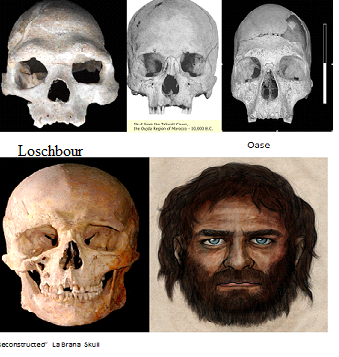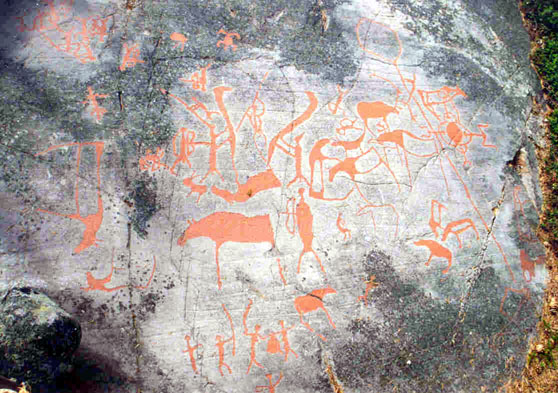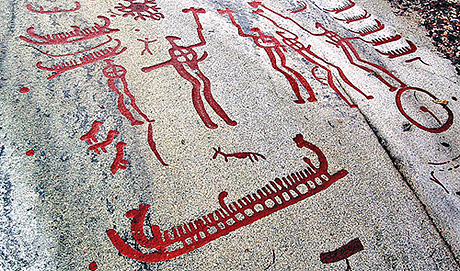Their Polish names didn't help them when they/their families were expelled by those in power in Poland at the time.
In order to stay, they would need to apply for Polish citizenship and then prove their Polishness (many people succeeded in that - as in the census of 1950 there were about 1,2 million of such autochthons in areas annexed by Poland from Germany in 1945). If they did not even bother to apply for citizenship and to try staying, then they were going to be expelled in accordance with the Potsdam Agreement signed on 2 August 1945 and the calendar of deportations established by the Allied Control Council for Germany. It is also possible that their families were either evacuated by the German authorities or fled on their own already before the Red Army occupied their homes - as did the majority of Germans in territories annexed by Poland, or around half of them if counting those who tried to return. According to Polish historian Piotr Eberhardt, in total 6,682,000 German citizens were evacuated or escaped on their own in 1944-1945 from the territories which were later incoporated into Poland - the pre-war population of which was around 8,500,000. So up to 80% of all German citizens escaped or were evacuated.
* Of those 6,682,000 some returned (or tried to return), but in the end at least 50% escaped and did not try to return. When Polish administration first took over those lands from the Soviets, they already had just 1/2 of their pre-war population size. Eberhardt's figures are from his 2011 and 2006 publications:
2011:
http://rcin.org.pl/Content/15652/WA51_1 ... grafie.pdf
2006:
https://www.sendspace.com/file/t2akrp
*In reality probably less than 80% because while pre-war population was 8,500,000 - during WW2 the number of German citizens there increased, as many Germans were evacuated from cities in Western and Central Germany to areas of Eastern Germany in order to escape from Allied bombs. Those were not pre-war residents, they were there as refugees from the West, at the time when the Red Army was advancing.
Christopher Duffy estimates the number of those German refugees as about 7 million (not just from Poland, but in total):
See page 276, the beginning of chapter "The Experience of the Catastrophe" (links below):
https://archive.org/stream/Red_Storm_on ... 0/mode/2up
https://archive.org/stream/Red_Storm_on ... h_djvu.txt
https://archive.org/details/Red_Storm_on_the_Reich
Quote:
"(...) As early as 28 January 1945, the Wehrmacht calculated that 3.5 million German civilians were on the move in the East. By the end of the war the number of German non-combatants fleeing from the Russians had nearly doubled to about 7 million. Most of those who tried to stay in their homes were evicted after the war, a process which by 1950 brought the number of Germans displaced by the Russians and their clients to a final total of 11 million. (...)"
Also this website says that around half of all Germans escaped permanently (= did not even try to return after escaping):
http://www.transodra-online.net/de/node/1410
Vor dem Krieg hatten in den Gebieten, die in Potsdam Polen zugesprochen wurden, 8,5 Mio. Bewohner gelebt. Als die Front näherrückte, verließ die Hälfte von ihnen ihre Wohnorte und zog Richtung Westen. Dies war eine Folge der von den deutschen Behörden angeordneten Zwangsevakuierung sowie der panischen Flucht der Bewohner vor der Roten Armee. Nach Beendigung der Kriegshandlungen blieben noch etwa 2,5 Mio. Deutsche in Schlesien, 1 Mio. in Pommern, 550.000 in Ostpreußen, 350.000 im Lebuser Land und 200.000 auf dem Gebiet der ehemaligen Freistadt Danzig.
Im Lebuser Land blieben etwa 30 Prozent der Deutschen in ihren Wohnstätten zurück. Meistens waren es Frauen, Kinder und Alte. Die Städte und Dörfer des Lebuser Landes waren stärker entvölkert als die Ortschaften in Ostpreußen, Schlesien oder Pommern. Die Zahl der gebliebenen Deutschen war aber in einzelnen Kreisen unterschiedlich. Die größte Entvölkerung war im Kreis Crossen / Krosno zu verzeichnen: Hier blieben nur acht Prozent der Bevölkerung. Im Kreis Glogau / Głogów waren es etwa neun Prozent, im Kreis Sorau / Żary zehn Prozent, im Kreis Frankfurt Oder siebzehn Prozent, im Kreis Sprottau / Szprotawa und im Kreis Sagan / Żagań fünfzehn bis zwanzig Prozent. Im östlich der Lausitzer Neiße gelegenen Teil des Kreises Guben / Gubin blieben etwa zwölf Prozent der deutschen Bevölkerung.
Nach Durchzug der Front kehrte ein Teil der Bewohner in ihre früheren Wohnorte zurück. Daher stieg die Zahl der Deutschen in einzelnen Städten und Dörfern am rechten Ufer von Oder und Neiße erneut an, wenngleich sie auch nicht annähernd den Vorkriegsstand wieder erreichte. Beispielsweise wohnten Anfang Juni 1945 im Kreis Sorau / Żary noch 51 Prozent der deutschen Vorkriegsbevölkerung, im Kreis Landsberg an der Warthe / Gorzów waren es 40 Prozent, im Kreis Meseritz / Międzyrzecz 25 Prozent, im Kreis Sprottau / Szprotawa und Sagan / Żagań 38 Prozent und im Kreis Frankfurt (Oder) 40 Prozent. Im Kreis Guben / Gubin lebten zu diesem Zeitpunkt noch 30 Prozent und im Stadtteil am rechten Neißeufer nur noch fünf Prozent der deutschen Vorkriegsbevölkerung.
Ein Teil der deutschen Staatsbürger in den Gebieten östlich von Oder und Neiße, die weder evakuiert worden noch vor der Front geflüchtet waren, waren Menschen polnischer Herkunft (sogenannte Autochthone). Polnische Behörden schätzten ihre Zahl auf ca. 1,2 Mio. (jeweils einige Hunderttausend in Oberschlesien, Ermland und Masuren). Im Lebuser Land sollen laut dieser Schätzungen etwa 20.000 Personen polnischer Herkunft gelebt haben. Insgesamt waren diese Zahlen jedoch wesentlich überhöht, obwohl gerade sie zu einem der Hauptargumente wurden, nach dem Krieg eine breitangelegte Verifikation der nationalen Zugehörigkeit durchzuführen. Es ging darum, diejenigen, die als einheimische polnische Bevölkerung galten, von den Deutschen zu trennen. Die einheimische Bevölkerung sollte repolonisiert und die Deutschen sollten aus Polen ausgesiedelt werden. (...)
Autochthons of pre-1945 German who remained in Poland numbered 1,2 million in 1950, including over 0,9 million in pre-1945 German Silesia (population of the Polish part of Upper Silesia is of course not included here as they were Polish citizens already before 1939).
=================================================================
There are many inaccuracies about those events being repeated all the time.
For example English wikipedia article about the town of Striegau (Strzegom), says:
In 1742 Striegau became part of Prussia. On June 4, 1745 the Battle of Hohenfriedberg, an important victory for King Frederick II during the War of the Austrian Succession, took place near the town. In the 19th century considerable industrial expansion took place, with granite quarries playing a particularly important role in the town's economy. The first rail link to the town was opened in 1856. In 1905 the town of Striegau had 13,427 inhabitants. During World War II, Nazi Germany used an area close to the town as a subcamp of the nearby Gross-Rosen concentration camp. As a result of the Potsdam Conference in 1945, Striegau became a part of Poland, and its German inhabitants were expelled. The town was renamed Strzegom by the People's Republic of Poland.
But according to Christopher Duffy, there was actually nobody left to be expelled from Striegau.
Because the Soviets had slaughtered the entire population of that town (except for a few survivors) - quote:
"(...) Again and again we hear of the Russian tank forces opening fire on trains, or driving straight down columns of civilian refugees, crushing people and animals and machine-gunning the survivors in the ditches and fields. Massacre, rape and plunder contributed to the very marked decline in discipline that was evident in the last ten days of January, when the Russians moved into German territory. The marshals were appalled, and in his ferocious order of 27 January [1945] Konev cited a number of spectacular lapses and gave a long list of commanders who had been consigned to penal battalions. One of his officers remarked on a tank battalion where the tanks were so tightly packed with loot and plunder that the members of the crew could not move inside and would have been unable to go into action in case of emergency. (...) The Russian way with German civilians first became known after the Germans recaptured the town of Nemmersdorf in East Prussia, which was the scene of a wholesale massacre of the population in October 1944. This experience was relived on every theatre of the Eastern Front, and on every occasion it provoked in the German troops an intense desire for revenge. In Silesia the grisly findings extended into March. At Sagan the Germans beat Russians to death with shovels and rifle butts; at Striegau, which was cleared by the 208th Infantry Division, the few surviving civilians were wandering around literally out of their minds. 'After Striegau there was no question of giving quarter. When the soldiers were asked to hold themselves back, they replied in words to the effect that: 'After what we saw and lived through at Striegau, you can't ask us to take prisoners' (Ahlfen, 1977, 169; see also Neidhardt, 1981, 379). (...)"
There are words which carry the presage of defeat. Defence is such a word. What is the result of an even victorious defence? The next attempt of imposing it to that weaker, defender. The attacker, despite temporary setback, feels the master of situation.

















